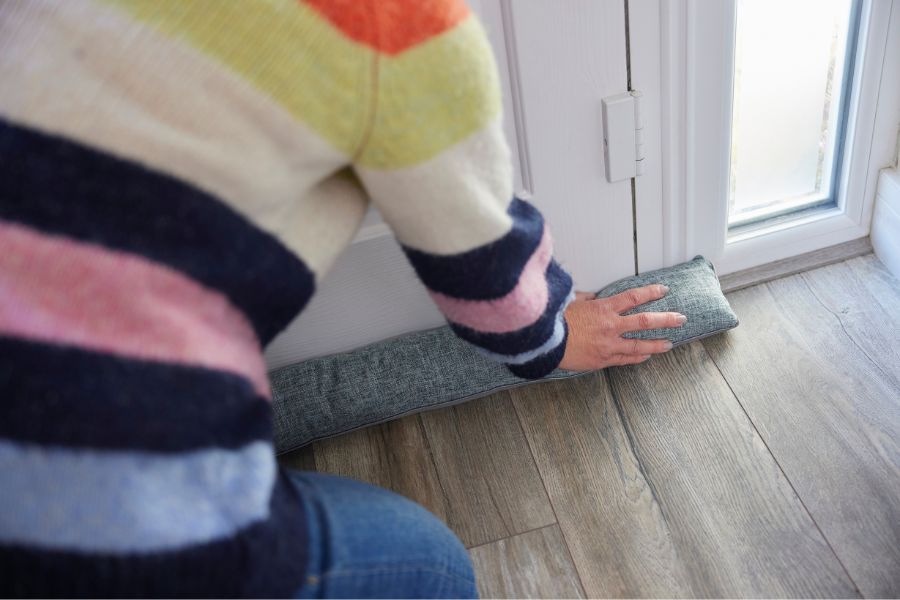Boiler how-to
Draught proofing your home
22 Apr 2024 • 7 minutes


Are you eager to keep the warm air in and the cold air out in your home? Draught-proofing can be one of the cheapest and most effective ways to save on your energy bills.
Here are some of the key benefits of draught-proofing your home:
There are several ways homeowners can insulate their property. Here are some things you can do to draught-proof your home:
Draughts from outside can make their way into your home through gaps under your doors, fireplaces, and even letterboxes. Search your home for uncovered gaps and openings to the outside; that way you’ll be able to stop warm air from escaping.
Here are the most common areas where you’ll find draughts in your home:

Self-adhesive foam or rubber strips can easily be attached to window frames. The rubber strips are the stronger of the two and much more hard-wearing. These can be purchased in a variety of sizes at your local DIY store.
There are different types available including P and E profile seals that come in different thicknesses and quality, so make sure you choose the right type for your window. These are easy to attach to the inside of window frames and do not require any additional tools to fit.
One disadvantage is that they are not as durable as other alternatives such as brush or hinged flap strips and don’t work on sliding windows. If you do own sliding windows you will need to look into other options.
External doors should be your main priority, as this is where cold air will most likely enter your property.
For a temporary fix for interior doors, the fabric shop-bought or homemade draught excluders will do the trick.
Keyholes can be a common source of draughts, but something as simple as a brass cover that pivots over the lock can be a great remedy.
Fit your letterbox with a strong, spring-mounted flap. An additional interior flap or brush unit can also be fitted to neaten the appearance of the opening and of course, further reduce draughts.
Top tip: Remember to measure your letterbox before purchasing any materials to draught-proof letterboxes.
You can block cracks in your floorboards and skirting boards by squirting fillers into the gaps.
Remember, filling or sealing the gaps in floorboards may be noticeable (unless you’re painting or applying dark stain). There are several methods to follow:
Top tip: Due to the natural contraction and expansion of floorboards and skirting boards, it’s important to use a filler that is flexible e.g. silicone-based.
Heat rises, so it’s worth looking into the possibility of draught-proofing your loft hatch. You can insulate these by using foam strips.
Top tip: Insulate the top of the loft hatch with insulating wool. Simply glue a carrier bag to the top of the hatch, fill with the insulating material, and tape shut.
If you don’t use your fireplace very often, you could fit a cap over the chimney pot (best left to the professionals to get up there!) or purchase a chimney draught excluder. Just remember to remove these if you do decide to light a fire.
Another simple way to minimise your home’s heat loss is to insulate the water tanks and cylinders in your house. Use a British Standard cylinder jacket to wrap around your hot water cylinder so it’s covered as much as possible, but be careful not to wrap it too tight as this will reduce the effectiveness of the insulation.
For small gaps around pipework, you can use silicone fillers, and for larger gaps expanding foam will do the trick. Simply spray carefully into the gap, wait for the polyurethane foam to expand and dry fully.
Energy Saving Trust says that: “draught-proofing around your windows and doors could save you around £20 a year. Meanwhile, if you have an open chimney, draught-proofing it whilst it’s not being used could save around £15 a year.”
They estimate that if draught-proofing measures were installed, the average UK household would save £60 a year on heating bills. And if every home were draught-proofed, that would amount to £190 million or the equivalent of heating nearly 400,000 homes with all that saved energy!
If you’ve decided to insulate your home to get rid of those pesky draughts, it’s worth remembering that air still needs to flow out of your house, especially in rooms where lots of moisture is produced (kitchens and bathrooms).
To ensure your home still allows air to flow through rooms, don’t block or seal the following:
Looking for help and guidance with heating your home efficiently beyond draught-proofing? Swapping your old boiler for a new a-rated boiler is a great way to increase your energy efficiency.
We’re working together with BOXT, one of the largest boiler installation companies in the UK, to help you find the best boiler for your home.
BOXT makes choosing the perfect new boiler for your home easy with a fixed price quote on your screen in just 90 seconds.
Our help & advice articles cover Plumbing, Home heating, Electrical, Energy-saving and Home maintenance.